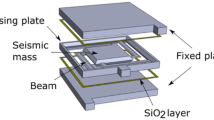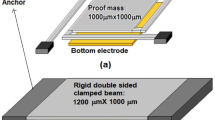Abstract
In this work, the response of the z-axis differential capacitive MEMS accelerometer structure is studied under mechanical shock. The resonant frequency of the accelerometer is 9.12 kHz, and the corresponding time-period (Tn) is 0.11 ms. Simulation of the accelerometer structure under 30 g half-sine acceleration shocks of different durations (0.1–4 ms) revealed that the output amplitude attains the input acceleration shock value when the pulse duration (T) ≥ 0.9 ms. The simulated output time-lag over the input pulse is found to be around 0.2 ± 0.03 msec. The accelerometer showed higher rise-time (10−90 %) and fall-time (90−10 %) for the 0.1–0.5 ms shock pulse durations. The silicon-on-insulator (SOI) MEMS technology is employed to fabricate the accelerometer structure. The packaged accelerometer is tested under the 30 g half-sine acceleration shocks generated by an electrodynamic shaker. The measured output amplitude of the accelerometer achieved the input acceleration value when the shock pulse duration (T) ≥ 9Tn, and the measured time-lag varies from 0.05 to 0.3 msec. The measurement results showed that the output follows the input shock pulse when rise-time (tr) ≥ Tn and fall-time (tf) ≥ 2.7 Tn. The high value of pre-pulse noise is observed for the lower shock-pulse duration (≤ 0.5 ms), and the noise level (peak-to-peak) gets substantially minimized only when T ≥ 27 Tn.






Similar content being viewed by others
References
Aizawa T, Kimura T, Matsuoka T, Takeda T, Asano Y (2008) Application of MEMS accelerometer to geophysics. Int J JCRM 4:33–36
Bao M (2005) Analysis and design principles of MEMS devices. Elsevier, Amsterdam
Bhan RK, Shaveta, Panchal A, Parmar Y, Sharma C, Pal R, Dutta S (2015) Determination of multiple spring constants, gaps and pull-down voltages in MEMS CRAB type microaccelerometer using near pull down capacitance voltage measurements. Sens Transducers 192:44–52
Bhan RK, Shaveta I, Md, Pal R, Dutta S (2015) An improved analytical approach for estimation of misalignment error of sensing axis in MEMS accelerometers using simple tilt measurements. Sens Transducers 189:128–136
Bhan RK, Shaveta I, Md, Pal R, Dutta S, Yadav I (2016) Development of unified fabrication process and testing of MEMS based comb and crab type capacitive accelerometers for navigational applications. Sens Transducers 203:8–15
Daeichin M, Ozdogan M, Towfighian S, Miles R (2019) Dynamic response of a tunable MEMS accelerometer based on repulsive force. Sens Act A 289:34–43
Dutta S, Shaveta, Pal R, Bhattacharya DK, Datta P, Chatterjee R (2008) Design and analysis of wet-etching based comb type capacitive accelerometer. Sens Transducers 91:31–38
Dutta S, Kumar M, Kumar S, Imran Md, Yadav I, Kumar A, Kumar P, Pal R (2014a) Lapping assisted dissolved wafer process of silicon for MEMS structures. J Mater Sci: Mater Electron 25:1984–1990
Dutta S, Shaveta I, Md, Pal R, Bhan RK (2014b) Diffusion induced residual stress in comb-type microaccelerometer structure. J Mater Sci: Mater Electron 25:3828–3832
Dutta S, Saxena P, Panchal A, Pal R, Jain KK, Bhattacharya DK (2018) Effect of vacuum packaging on bandwidth of push–pull type capacitive accelerometer structure. Microsyst Technol 24:4855–4862
Fan K, Che L, Xiong B, Wang Y (2007) A silicon micromachined high-shock accelerometer with a bonded hinge structure. J Micromech Microeng 17:1206–1210
Gesing AL, Masson ZN, Arellano DC, Alves F, Paul S, Cordioli JA (2019) Middle ear ossicular chain vibration detection by means of an optimized MEMS piezoelectric accelerometer. IEEE Sens 19:2079–2086
Ghisi A, Kalicinski S, Mariani S, De-Wolf I, Corigliano A (2009) Polysilicon MEMS accelerometers exposed to shocks: numerical–experimental investigation. J Micromech Microeng 19:035023
Guney MG, Li X, Chung VPJ, Paramesh J, Mukherjee T, Fedder GK (2018) High dynamic range CMOS-MEMS capacitive accelerometer array. In: Int Conf MEMS-2018, Belfast, Northern Ireland, UK
Gupta N, Dutta S, Panchal A, Yadav I, Kumar S, Parmar Y, Vanjari SRK, Jain KK, Bhattacharya DK (2019a) Design and fabrication of SOI technology-based MEMS differential capacitive accelerometer structure. J Mat Sci: Mater Electron 30:15705–15714
Gupta N, Pandey A, Vanjari SRK, Dutta S (2019b) Influence of residual stress on performance of AlN thin film based piezoelectric MEMS accelerometer structure. Microsyst Technol 25:3959–3967
Han J, Zhao Z, Niu W, Huang R, Dong L (2018) A low cross-axis sensitivity piezoresistive accelerometer fabricated by masked-maskless wet etching. Sens Act A 283:17–25
Hari K, Verma SK, Krishna IRP, Seena V (2018) Out-of-plane dual flexure MEMS piezoresistive accelerometer with low cross axis sensitivity. Microsyst Technol 24:2437–2444
Harris CM, Piersol AG (2002) Shock and vibration handbook, 5th edn. The McGraw-Hill Companies, New York
Huang W, Cai X, Xu B, Luo L, Li X, Cheng Z (2003) Packaging effects on the performances of MEMS for high-G accelerometer with double cantilevers. Sens Act A 102:268–278
Jia C, Zhao L, Jiang W, Liu X, Yu M, Huang M, Xia Y, Zhao Y, Zhao Y (2018) Impact experiment analysis of MEMS ultra-high G piezoresistive shock accelerometer. In: Int Conf. MEMS-2018, Belfast, Northern Ireland, UK
Keshavarzi M, Hasani JY (2019) Design and optimization of fully differential capacitive MEMS accelerometer based on surface micromachining. Microsyst Technol 25:1369–1377
Kobayashi T, Okada H, Masuda T, Maeda R, Itoh T (2011) A digital output accelerometer using MEMS-based piezoelectric accelerometers and arrayed CMOS inverters with satellite capacitors. Smart Mater Struct 20:065017
Kon S, Horowitz R (2008) A high-resolution MEMS piezoelectric strain sensor for structural vibration detection. IEEE Sensors 8:2027–2035
Liu F, Gao S, Niu S, Zhang Y, Guan Y, Gao C, Li P (2018) Optimal design of high-g MEMS piezoresistive accelerometer based on Timoshenko beam theory. Microsyst Technol 24:855–867
Mo Y, Du L, Qu B, Peng BB, Yang J (2018) Squeeze film air damping ratio analysis of a silicon capacitive micromechanical accelerometer. Microsyst Technol 24:1089–1095
Mukhiya R, Agarwal P, Badjatya S, Garg M, Gaikwad P, Sinha S, Singh AK, Gopal R (2019) Design, modelling and system level simulations of DRIE-based MEMS differential capacitive accelerometer. Microsyst Technol 25:3521–3532
Murphy C (2017a) Choosing the most suitable MEMS accelerometer for your application—Part 1. Analog Dialogue 51–10
Murphy C (2017b) Choosing the most suitable MEMS accelerometer for your application—part 1I. Analog Dialogue 51–11
Narasimhan V, Li H, Jianmin M (2015) Micromachined high-g accelerometers: a review. J Micromech Microeng 25:033001
Parmar Y, Gupta N, Gond V, Lamba SS, Vanjari SRK, Dutta S, Jain KK, Bhattacharya DK (2020) Characterization of SOI technology based MEMS differential capacitive accelerometer and its estimation of resolution by near vertical tilt angle measurements. Microsyst Technol 26:701–706
Shaeffer DK (2013) MEMS inertial sensors: a tutorial overview. IEEE Commun Mag 51:100–109
Shank B (2018) Adaptive shock pulses on an electro-dynamic shaker, whitepaper, thermotron industries. https://thermotron.com/adaptive-shock-pulses-on-an-electrodynamic-shaker-whitepaper
Shi Y, Zhao Y, Feng H, Cao H, Tang J, Li J, Zhao R, Liu J (2018) Design, fabrication and calibration of a high-G MEMS accelerometer. Sens Act A 279:733–742
Tao YK, Liu YF, Dong JX (2014) Flexible stop and double-cascaded stop to improve shock reliability of MEMS accelerometer. Microelectron Reliab 54:1328–1337
Walter PL (2008) Selecting accelerometers for and assessing data from mechanical shock measurements, Technical Note (TN 24), PCB Piezotronics Inc
Wang LP, Wolf RA, Wang Y, Deng KK, Zou L, Davis RJ, Mckinstry ST (2003) Design, fabrication, and measurement of high-sensitivity piezoelectric micro-electro-mechanical systems accelerometers. IEEE MEMS 12:433–439
Watson NF (1986) Accelerometer system. U.S. Patent 4601206 A
Xu Y, Zhao L, Jiang Z, Ding J, Xu T, Zhao Y (2016) Analysis and design of a novel piezoresistive accelerometer with axially stressed self-supporting sensing beams. Sens Act A 247:1–11
Yan Z, Hou B, Zhang J, Shen C, Shi Y, Tang J, Cao H, Liu J (2019) MEMS accelerometer calibration denoising method for Hopkinson bar system based on LMD-SE-TFPF. IEEE Access 7:113901
Yang Z, Huang Y, Li X, Chen G (2009) Investigation and simulation on the dynamic shock response performance of packaged high-g MEMS accelerometer versus the impurity concentration of the piezoresistor. Microelectron Reliab 49:510–516
Yazdi N, Ayazi F, Najafi K (1998) Micromachined inertial sensors. Proc IEEE 86:1640–1659
Yu JC, Lan CB (2001) System modeling of microaccelerometer using piezoelectric thin films. Sens Act A 88:178–186
Zou H, Wang J, Chen F, Bao H, Jiao D, Zhang K, Song Z, Li X (2017) Monolithically integrated tri-axis shock accelerometers with MHz-level high resonant-frequency. J Micromech Microeng 27:075009
Acknowledgements
The authors would like to thank Director SSPL for permission to publish this work. Nidhi Gupta would like to thanks the funding agency of the Government of India for providing her assistantship. The authors also sincerely thank the MEMS fabrication team of STARC, Bangalore. Help from other colleagues is also acknowledged.
Author information
Authors and Affiliations
Corresponding author
Additional information
Publisher’s Note
Springer Nature remains neutral with regard to jurisdictional claims in published maps and institutional affiliations.
Rights and permissions
About this article
Cite this article
Gupta, N., Dutta, S., Parmar, Y. et al. Characterization of SOI MEMS capacitive accelerometer under varying acceleration shock pulse durations. Microsyst Technol 27, 4319–4327 (2021). https://doi.org/10.1007/s00542-021-05227-y
Received:
Accepted:
Published:
Issue Date:
DOI: https://doi.org/10.1007/s00542-021-05227-y




